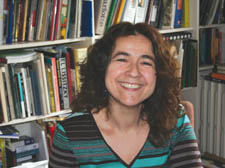|
|
 |
| |

Monica Bohm-Duchen |
Camden features | interview with Historian Monica Bohm-Duchen on artists fleeing from Nazi Germany | NW3 |
Why did artists fleeing from
Nazi Germany settle in NW3? Dan Carrier talks to historian Monica Bohm-Duchen about this community in exile
WHEN artists fled for their lives from Nazi Germany in the 1930s, Hampstead became a destination for many and the result was an unofficial artists’ community in exile.
The bars, pubs and coffee houses of the area played host to a wide a variety of European refugees, all forced to come to Britain and start again.
Their legacy is famous: Hampstead’s reputation, established in the 19th century as an area for artists and writers by the likes of Constable and Keats, was furthered by the influx of central Europeans who were at the forefront of modernist movements.
Next week art historian Monica Bohm-Duchen is presenting a lecture at Burgh House, revealing how Hampstead provided a safe haven. As she says: “Hitler shook the tree, and we collected the apples.”
Monica has a personal link to émigrés and the area. Her mother is the well-known photographer Dorothy Bohm, herself a European exile.
One of the inspirations for the talk came from a show she curated in the 1980s called Art in Exile, which was mainly based on artists who had sought refuge from the Nazis.
“It struck me that they were all based in NW3,” she recalls. “It was extraordinary. NW3 had a reputation for radical politics and arts and this was partly based on the fact so many émigrés had settled here.”
Hampstead was not the well-heeled place it is today: cheap rents and a relaxed atmosphere made it a natural place for an artist to settle.
The Hampstead-based Surrealist artist Roland Penrose helped German refugees enter the UK by establishing the Artists’ Refugee Committee which was responsible for saving hundreds of lives.
To get visas for Britain, artists needed a guarantor to show they would not be a burden on the state plus an offer of work.
“Women were offered jobs as domestic helps, but it was harder for the men,” says Monica. “The committee would establish links, provide temporary rooms and generally smooth the way for artists.”
Penrose had been based in Paris but returned to England in 1936 and bought number 21 Downshire Hill.
He was attracted to Downshire Hill after meeting the architect Erno Goldfinger in Paris. He lived nearby and was to build a home celebrating the best of modern architecture in Willow Road. The numbers of avant garde artists, writers and left-wing academics also made it the natural place for Penrose to settle.
“He was not known as a great artist himself,” says Monica. “But he was extremely influential. He introduced Britain to Surrealism from Paris.”
Henry Moore’s studio in Belsize Park was also a draw: Penrose had gone with Moore to visit Picasso while the painter was producing Guernica, and after he moved into Downshire Hill, Moore gave him a sculpture entitled Mother and Child.
Penrose placed it in his front garden in Downshire Hill and caused a scandal: a press campaign was waged, forcing him to move it.
“Roland was friends with the sculptor Barbara Hepworth and the painters Piet Mondrian and Paul Nash,” says Monica. “He knew Wells Coates, who built the Isokon in Lawn Road, and the Bauhaus architect Walter Gropius who lived there.”
He also was close to the art critic Herbert Read, who also lived in Downshire Hill, who was later to found the Institute of Contemporary Arts with Penrose. In 1938, he had bought the Cork Street gallery to champion Surrealism.
“While places like Fitzjohns Avenue were seen as rather staid and bourgeois, Downshire Hill was considered to be run down. People hung their laundry in the front gardens.”
He told friends he had been drawn to Hampstead because it reminded him of happier days on the Left Bank: “I found a climate that had a resemblance to the one that I had left behind in Paris.”
Other attractions included the Everyman cinema. “It specialised in art house,” reveals Monica. “They also held exhibitions in the foyer. Barbara Hepworth gave a show there.”
In 1938, Penrose’s New Burlington Gallery hosted a show called Modern German Art which was riposte to the 1936 Degenerate Art exhibition in Munich.
“Hitler was to wage a battle against what he called degenerate art. The exhibition was put on so people could come in... to poke fun at how bad and morally wrong modern art was.”
Penrose’s Modern German show was designed to introduce people positively to the works done there. Sadly, it was not well received by everyone, says Monica: “A critic for the New Statesman said he found everything ugly, and that when he had heard Hitler condemned it, it was the best thing he had heard about Hitler.”
|

|
 |
|
 |
|

